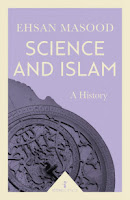 Staff review by Chris Saliba
Staff review by Chris SalibaEhsan Masood opens our eyes to the history of scientific achievement in the Islamic world.
A scientific tradition is not something we equate with Islam. London based science writer Ehsan Masood tries to rectify this error in his appealing history, Science and Islam. Covering roughly the period between the ninth and thirteenth centuries, Masood concentrates on what is considered an Islamic Golden Age. Islam produced a wealth of great thinkers in the sciences during this era: geographers, astronomers, physicians, engineers, pharmacologists, inventors, surgeons, mathematicians etc. The list is almost endless.
This Golden Age started under the Abbasid caliphate, when Islamic scholars energetically took to translating the great works of Greek and Roman thinkers. Coupled with this enthusiasm for translation was the mastering of paper production, learnt from the Chinese. This would have a huge impact on the spread of learning, as paper was so versatile.
One discipline where Islam truly excelled was medicine. Hospitals during the Golden Age employed physicians, surgeons and opthalmologists, as well as nurses, administrators and orderlies. Another area in which Islam excelled was astrology. The need to pray five times a day meant that there was always a strong interest in studying the slant of the sun and the position of the stars, so as to ascertain correct prayer times. Historians agree that eminent Islamic astrologers influenced Copernicus.
The most obvious influence of Islamic science on the world today is in the use of Arabic numerals. While what we call Arabic numerals were actually derived from India, it was the mathematician al-Khwarizmi who perfected the system we use for modern science and commerce. Key scientific words such as algebra, algorithm and alchemy are also Islamic in their provenance.
Science and Islam offers an accesible overview of some 500 years of Islamic thought and scientific endeavour. Ehsan Masoon writes in a beautiful lapidary prose, making his book a joy to read. The sections on great Islamic cities in their hey day, like Bagdad and Cairo, are a special treat for the reader who likes to time travel to exotic times and places. How magical Baghdad must have been in the ninth century, when it was the fabled city of The Thousand and One Arabian Nights.
A book that helpfully explains the rise of Islamic science, it unfortunate fall, and what needs to be done now to encourage scientific learning in the modern Islamic world.
To sign up for our monthly newsletter, featuring new releases, book reviews and favourite articles from around the web, click here.
No comments:
Post a Comment